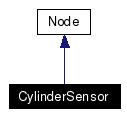 6.17
CylinderSensor
6.17
CylinderSensor
The CylinderSensor node maps pointer motion (e.g., a mouse or wand)
into a rotation on an invisible cylinder that is aligned with the Y-axis
of the local coordinate system. The CylinderSensor uses the descendent geometry
of its parent node to determine whether it is liable to generate events.
The enabled exposed field enables and disables the CylinderSensor
node. If TRUE, the sensor reacts appropriately to user events. If FALSE,
the sensor does not track user input or send events. If enabled receives
a FALSE event and isActive is TRUE, the sensor becomes disabled and
deactivated, and outputs an isActive FALSE event. If enabled
receives a TRUE event the sensor is enabled and ready for user activation.
A CylinderSensor node generates events when the pointing device is activated
while the pointer is indicating any descendent geometry nodes of the sensor's
parent group. See 4.6.7.5, Activating and manipulating sensors,
for more details on using the pointing device to activate the CylinderSensor.
Upon activation of the pointing device while indicating the sensor's
geometry, an isActive TRUE event is sent. The initial acute angle
between the bearing vector and the local Y-axis of the CylinderSensor node
determines whether the sides of the invisible cylinder or the caps (disks)
are used for manipulation. If the initial angle is less than the diskAngle,
the geometry is treated as an infinitely large disk lying in the local Y=0
plane and coincident with the initial intersection point. Dragging motion
is mapped into a rotation around the local +Y-axis vector of the sensor's
coordinate system. The perpendicular vector from the initial intersection
point to the Y-axis defines zero rotation about the Y-axis. For each subsequent
position of the bearing, a rotation_changed event is sent that equals
the sum of the rotation about the +Y-axis vector (from the initial intersection
to the new intersection) plus the offset value. trackPoint_changed
events reflect the unclamped drag position on the surface of this disk.
When the pointing device is deactivated and autoOffset is TRUE, offset
is set to the last value of rotation_changed and an offset_changed
event is generated. See 4.6.7.4, Drag sensors,
for a more general description of autoOffset and offset fields.
If the initial acute angle between the bearing vector and the local Y-axis
of the CylinderSensor node is greater than or equal to diskAngle,
then the sensor behaves like a cylinder. The shortest distance between the
point of intersection (between the bearing and the sensor's geometry) and
the Y-axis of the parent group's local coordinate system determines the
radius of an invisible cylinder used to map pointing device motion and marks
the zero rotation value. For each subsequent position of the bearing, a
rotation_changed event is sent that equals the sum of the right-handed
rotation from the original intersection about the +Y-axis vector plus the
offset value. trackPoint_changed events reflect the unclamped
drag position on the surface of the invisible cylinder. When the pointing
device is deactivated and autoOffset is TRUE, offset is set
to the last rotation angle and an offset_changed event is generated.
More details are available in 4.6.7.4, Drag
sensors.
When the sensor generates an isActive TRUE event, it grabs all
further motion events from the pointing device until it is released and
generates an isActive FALSE event (other pointing-device sensors
shall not generate events during this time). Motion of the pointing device
while isActive is TRUE is referred to as a "drag." If a
2D pointing device is in use, isActive events will typically reflect
the state of the primary button associated with the device (i.e., isActive
is TRUE when the primary button is pressed and FALSE when it is released).
If a 3D pointing device (e.g., a wand) is in use, isActive events
will typically reflect whether the pointer is within or in contact with
the sensor's geometry.
While the pointing device is activated, trackPoint_changed and
rotation_changed events are output and are interpreted from pointing
device motion based on the sensor's local coordinate system at the time
of activation. trackPoint_changed events represent the unclamped
intersection points on the surface of the invisible cylinder or disk. If
the initial angle results in cylinder rotation (as opposed to disk behaviour)
and if the pointing device is dragged off the cylinder while activated,
browsers may interpret this in a variety of ways (e.g., clamp all values
to the cylinder and continuing to rotate as the point is dragged away from
the cylinder). Each movement of the pointing device while isActive
is TRUE generates trackPoint_changed and rotation_changed
events.
The minAngle and maxAngle fields clamp rotation_changed
events to a range of values. If minAngle is greater than maxAngle,
rotation_changed events are not clamped. The minAngle and
maxAngle fields are restricted to the range [-2 , 2
, 2 ].
].
More information about this behaviour is described in 4.6.7.3,
Pointing-device sensors, 4.6.7.4, Drag
sensors, and 4.6.7.5, Activating and
manipulating sensors.



![]() , 2
, 2![]() ].
].![]()
 version 1.3.9.1.
version 1.3.9.1.